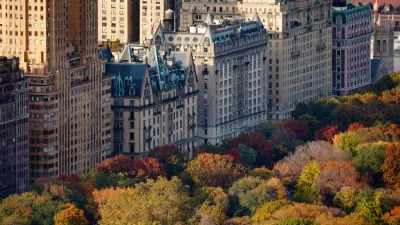President's Trump's name appears on six fewer buildings in Manhattan than on Election Day 2016.

David A. Farenthold has the story of President Trump's act in Manhattan:
On Election Day 2016, six residential buildings called Trump Place stood in a row on Manhattan’s Upper West Side — a legacy of Donald Trump’s efforts to develop that site and a sign of the Trump name’s enduring value in New York.
Soon, Trump’s name will be gone from all of them.
Two buildings, over a span of two days, decided to remove Trump's name. The last holdout was the building formerly known as Trump Place, located at 220 Riverside Boulevard on the Upper West Side.
A vote of 83 percent of the building's condo owners decided the matter. Of those that voted, "74.7 percent voted to remove the signage, and 25.3 percent voted not to remove the signage," according to Farenthold. The day before, the condo board at 120 Riverside Boulevard decided to remove Trump's name from that building.
"These decisions signal how Trump’s politics has become a weight on his brand in some of the foreign countries and liberal U.S. cities, particularly Manhattan, the city that gave him his start," according to Farenthold. "At both of these buildings, residents were willing to spend money to remove any trace of Trump’s name from their facades."
As noted by Farenthold, Trump's name hasn't been completely erased from the borough. Nine buildings, including Trump Tower, still bear the president's name in Manhattan.
FULL STORY: For the second time in two days, a building called Trump Place decides to take down the president’s name

Alabama: Trump Terminates Settlements for Black Communities Harmed By Raw Sewage
Trump deemed the landmark civil rights agreement “illegal DEI and environmental justice policy.”

Planetizen Federal Action Tracker
A weekly monitor of how Trump’s orders and actions are impacting planners and planning in America.

The 120 Year Old Tiny Home Villages That Sheltered San Francisco’s Earthquake Refugees
More than a century ago, San Francisco mobilized to house thousands of residents displaced by the 1906 earthquake. Could their strategy offer a model for the present?

Indy Neighborhood Group Builds Temporary Multi-Use Path
Community members, aided in part by funding from the city, repurposed a vehicle lane to create a protected bike and pedestrian path for the summer season.

Congestion Pricing Drops Holland Tunnel Delays by 65 Percent
New York City’s contentious tolling program has yielded improved traffic and roughly $100 million in revenue for the MTA.

In Both Crashes and Crime, Public Transportation is Far Safer than Driving
Contrary to popular assumptions, public transportation has far lower crash and crime rates than automobile travel. For safer communities, improve and encourage transit travel.
Urban Design for Planners 1: Software Tools
This six-course series explores essential urban design concepts using open source software and equips planners with the tools they need to participate fully in the urban design process.
Planning for Universal Design
Learn the tools for implementing Universal Design in planning regulations.
Clanton & Associates, Inc.
Jessamine County Fiscal Court
Institute for Housing and Urban Development Studies (IHS)
City of Grandview
Harvard GSD Executive Education
Toledo-Lucas County Plan Commissions
Salt Lake City
NYU Wagner Graduate School of Public Service





























